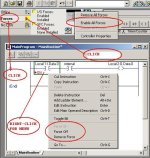Allen-Bradley forces vs. Omron forces - any differences?
Greetings BobB,
I’m pretty sure that what Gerry is talking about is the fact that with Allen-Bradley you do not actually force BITS at all ... whether they are internal or real-world bits makes no difference ... naturally when I say “bit” I’m talking about a “one-or-zero” status “box” on a data table ... specifically a “bit” is NOT the real-world device that might be associated with the bit ... I’m sure that you’re quite aware of the distinction – but some of our beginner readers might not be fully aware of the difference ...
with Allen-Bradley the basic idea is that when you force a real-world INput, then the force is not applied to the input bit ... actually the force is applied “upstream” of the bit (between the input module and the bit) ... since the logic signal is flowing INTO the bit, then the bit DOES reflect the ON or OFF status of the force ... specifically, if the force is ON, then the bit will be ON (=1) ... if the force is OFF, then the bit will be OFF (=0) ... regardless of the actual ON or OFF status of the real-world device in the field ...
on the other hand ...
when you force a real-world OUTput, then the force is not applied to the output bit ... actually the force is applied “downstream” of the bit (between the bit and the output module) ... since the logic signal is flowing OUT OF the bit, then the bit does NOT reflect the ON or OFF status of the force ... specifically, if the program’s logic is turning the bit ON (=1), then the bit will stay ON (=1) – regardless of a force to an OFF condition ... likewise, if the program’s logic is turning the bit OFF (=0), then the bit will stay OFF (=0) – regardless of a force to an ON condition ... more specifically, the real-world output will be forced ON or OFF – but the status of the output bit will NOT be affected by the force ...
now that’s for Allen-Bradley ... personally I’ve never worked with an Omron ... I’d really be interested in knowing just how their forces work ... specifically, when you force a real-world INput ON and OFF, does the status of the bit (on the data table) actually change too? ... I’m betting that it does ... on the other hand ... when you force a real-world OUTput ON and OFF, does the status of the bit (on the data table) actually change? ... at this point in time I wouldn’t bet anything more than pocket change on that particular question ... but I’d really like to know for sure ... is there anyway that you could run a little test for us and post the results? ...
for those who want to dig a little deeper into this subject, I covered it in a little more detail quite awhile back in
this post ... and for anyone who just can’t get enough of this type of thing, I suggest that you explore the differences between the Allen-Bradley operations of “force” and “toggle bit” ... there is plenty of room for confusion here – at least until you get familiar with the basic rules ...

